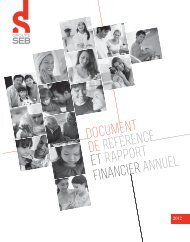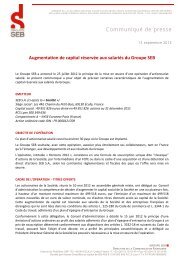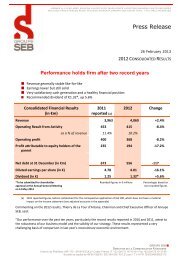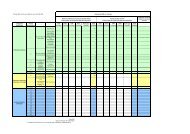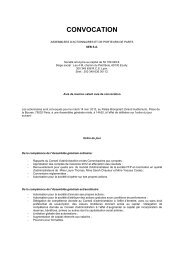Financial Report and Registration Document 2010 - Groupe Seb
Financial Report and Registration Document 2010 - Groupe Seb
Financial Report and Registration Document 2010 - Groupe Seb
You also want an ePaper? Increase the reach of your titles
YUMPU automatically turns print PDFs into web optimized ePapers that Google loves.
3 NOTES<br />
CONSOLIDATED FINANCIAL STATEMENTS<br />
TO THE CONSOLIDATED FINANCIAL STATEMENTS<br />
amendment to IFRIC 14 – Prepayments of a Minimum Funding<br />
Requirement. The amendment specifies that any prepayments of a<br />
minimum funding requirement under defined benefit plans must be<br />
recognised as an asset in the same way as any other prepayment;<br />
IFRIC 19 – Extinguishing <strong>Financial</strong> Liabilities with Equity Instruments.<br />
This interpretation provides guidance on accounting for agreements<br />
to settle a fi nancial liability fully or partially with shares or other equity<br />
instruments.<br />
1.1. BASIS AND SCOPE OF CONSOLIDATION<br />
Material companies that are exclusively controlled by SEB S.A. either directly<br />
or indirectly are fully consolidated.<br />
The profi ts of subsidiaries acquired or disposed of during the year are<br />
recognised in the consolidated income statement from the acquisition date<br />
or up to the disposal date.<br />
Where necessary, the financial statements of subsidiaries are restated to<br />
comply with Group accounting policies.<br />
Material companies over which SEB S.A. exercises signifi cant infl uence,<br />
directly or indirectly, are accounted for by the equity method. At 31 December<br />
<strong>2010</strong>, no entities were accounted for by the equity method.<br />
Certain companies fulfilling the above criteria are not consolidated because<br />
they are not material in relation to the Group as a whole. The materiality<br />
criteria applied by the Group are as follows:<br />
revenue of at least €10 million;<br />
total assets of at least €10 million;<br />
total debt of at least €5 million.<br />
The list of consolidated companies is presented in Note 32.<br />
All material intra-group transactions have been eliminated in consolidation.<br />
1.2. FOREIGN CURRENCY TRANSLATION<br />
1.2.1. Translation of the financial statements<br />
of foreign operations<br />
The financial statements of foreign entities are prepared in their functional<br />
currency, corresponding to the currency of the primary economic environment<br />
in which the entity operates. The functional currency of most foreign entities<br />
is their local currency.<br />
The euro is the Group’s functional currency <strong>and</strong> reporting currency.<br />
The financial statements of foreign entities are translated into euros by the<br />
closing rate method, as follows:<br />
assets <strong>and</strong> liabilities in a functional currency other than the euro are<br />
translated at the closing rate at the balance sheet date <strong>and</strong> income<br />
statement items are translated at the weighted average rate for the year;<br />
the resulting exchange differences are recognised as a separate<br />
component of equity, under “Translation reserve”.<br />
The financial statements of subsidiaries whose functional currency is not the<br />
local accounting currency are initially translated into the functional currency<br />
using the historical rate method, as follows:<br />
non-monetary assets <strong>and</strong> liabilities (non-current assets, inventories <strong>and</strong><br />
securities) <strong>and</strong> the corresponding movements recorded in the income<br />
statement are translated at the historical exchange rate;<br />
monetary assets <strong>and</strong> liabilities (cash, short <strong>and</strong> long-term loans <strong>and</strong><br />
borrowings, operating receivables <strong>and</strong> payables) are translated at the<br />
closing rate at the balance sheet date;<br />
income statement items are translated at the weighted average rate for<br />
the year, apart from depreciation, amortisation <strong>and</strong> impairment losses on<br />
non-monetary items;<br />
the resulting exchange differences are recognised in the income statement.<br />
These financial statements in the functional currency are then translated into<br />
euros using the closing rate method.<br />
In accordance with the option available to first-time adopters under IFRS 1,<br />
<strong>Groupe</strong> SEB elected to reset to zero at 1 January 2004 the cumulative<br />
translation differences arising on consolidation of foreign entities.<br />
1.2.2. Translation of foreign currency transactions<br />
Foreign currency transactions are recognised <strong>and</strong> measured in accordance<br />
with IAS 21 – The Effects of Changes in Foreign Exchange Rates.<br />
Transactions in currencies other than the euro are initially recognised at<br />
the exchange rate prevailing on the transaction date. Monetary assets <strong>and</strong><br />
liabilities denominated in currencies other than the euro are translated at the<br />
closing exchange rate, <strong>and</strong> the resulting exchange differences are recognised<br />
in the income statement.<br />
The effect of changes in exchange rates on the fair value of non-monetary<br />
fi nancial assets <strong>and</strong> liabilities is recognised by the accounting method<br />
applied to the category of financial assets or liabilities concerned.<br />
Monetary fi nancial assets are measured at amortised cost in the original<br />
currency <strong>and</strong> changes in amortised cost corresponding to exchange<br />
differences are recognised in the income statement, while other changes<br />
are recognised directly in equity.<br />
The Group’s exposure to certain currency risks is hedged using forward<br />
contracts <strong>and</strong> options (see Note 1.4.4 c) Derivative Instruments).<br />
1.3. USE OF ESTIMATES<br />
The preparation of consolidated fi nancial statements in accordance with<br />
IFRS requires the use of estimates <strong>and</strong> assumptions that have an impact<br />
on the reported amounts of assets <strong>and</strong> liabilities – such as accumulated<br />
depreciation, amortisation <strong>and</strong> impairment losses – <strong>and</strong> contingent assets<br />
<strong>and</strong> liabilities at the balance sheet date <strong>and</strong> income <strong>and</strong> expenses for the<br />
year.<br />
All such estimates are made on a going concern basis using the information<br />
available when the financial statements are drawn up. They reflect amounts<br />
<strong>and</strong> assumptions that management considers relevant <strong>and</strong> reasonable given<br />
the Group’s operating environment <strong>and</strong> past experience. In the current<br />
economic environment, short <strong>and</strong> medium-term forecasting has become<br />
more diffi cult. The estimates <strong>and</strong> assumptions used to prepare the <strong>2010</strong><br />
consolidated financial statements reflected the financial parameters shaping<br />
the market at 31 December. The value of certain assets, such as goodwill<br />
<strong>and</strong> trademarks, was estimated at the year-end based on the long-term<br />
economic outlook <strong>and</strong> management’s best estimates, taking into account<br />
the reduced visibility of future cash flows.<br />
68 FINANCIAL REPORT AND REGISTRATION DOCUMENT <strong>2010</strong> GROUPE SEB



